« September 2014 | Main | November 2014 »
October 31, 2014
Halloween: Meet me in the middle of the air.
Well, well, well, so I can die easy. Superlatives work here. Jimmy Page playing the first 3 numbers in shades and a grandiose, full Victorian morning coat is one of the coolest things I have ever seen and I may start a new religion based on his regal bearing and get-up alone. This is a 2007 concert with Jones, Plant and Page in their sixties and the late John Bonham's son Jason, on drums, maybe 40. I've never seen a live performance on video this good by any band, or seen 4 people having this much fun being excellent. If you're a Boomer who doesn't get this, you may be already dead.
Posted by JD Hull at 11:24 AM | Comments (0)
Greenwich Village Halloween Parade
.jpg)
Always at night, it's the largest Halloween parade in the world. 60,000 participants. A carnival. A debauch. A trip.
Posted by JD Hull at 12:20 AM | Comments (0)
October 30, 2014
2014 List: Wild Men. Wild Women.
 (3).jpg)
Wild Men. Wild Women. The Rankings 1 through 100 as this blog sees them in 2014. Wild Men and Wild Women are people who listen only to the little voice in their head. They get things done. They build things. They don't care what you think. Uncertainty and turbulence--in the economy, stock markets, governments, the weather, bad odds, you name it--only get their juices flowing. True, they often have dark and self-destructive sides, but we seem to like giving them a pass. A few lawyers on this list--but not enough. Lawyers. Are we just risk-averse uber-weenies? Sideline players? Bag carriers? Are we not Men, and Women?
1. Ben Franklin
2. Ted Turner
3. Dr. Johnson
4. Dr. Thompson
5. Theodore Roosevelt
6. Carl Bernstein
7. Michelangelo
8. Ayn Rand
9. Ana Marie Cox
10. Japan
11. Boudica
12. Winston Churchill
12. Benjamin Disraeli
14. Arianna Huffington
15. Bucky Fuller
16. Nino Scalia
17. Bill Buckley
18. Bill Clinton
19. Steve Jobs
20. Christopher Columbus
21. Nick Nolte
22. Jerry Lee Lewis
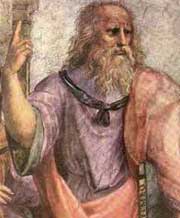
Plato (#27) was way Wild. Read the Timaeus.
23. The Welsh
24. Jann Wenner
25. Sean Penn
26. Ken Wilbur
27. Plato
28. Catherine the Great
29. Val Kilmer (way wilder than Jim Morrison)
30. Harry Dean Stanton
31. Scott Greenfield
32. Julius Caesar
33. Pete Seeger
34. John Lennon
35. Joseph P. Kennedy, Sr.
36. Peter Sheridan
37. Christopher Hitchens
38. Jerry Brown
39. Warren Beatty
40. Jack Nicholson
41. John the Baptist
42. Rahm Emanuel
43. Robert Mitchum
44. Joan of Arc and Charles Barkley (tie)
45. Dylan Thomas
46. Quentin Crisp
46. "E"
47. Boswell (he was Wild, too)
48. Ben Jonson
49. Mae West
50. Daniel Pinchbeck
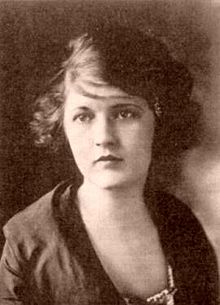
Zelda Fitzgerald (#90) was Wild. So was her childhood friend Tallulah Bankhead (#91).
51. Daniel O'Connell
53. David Boies
54. Elizabeth Wurtzel
55. St. John of Patmos
56. John Henry "Doc" Holliday
57. Genghis Khan
58. Alexander
59. Charles Bukowski
60. Gordon Liddy
61. Malcolm Lowry
63. Keith Moon
64. Charlie Munger
65. Babe Ruth
66. Chrissie Hynde
67. Colin Farell
68. Warren Zevon
69. Kim Jong-un (unknowable but one far-out little dude)
70. Billy Martin
71. Joe Namath
72. Guy de Maupassant
73. Grace Slick
74. Edna St. Vincent Millay
75. Mickey Mantle
76. François Villon
77. Friedrich Nietzsche
78. Rep. Bob Eckhardt (Texas-D) (gifted, eloquent, exotic)
79. Rachel Maddow
80. Ray Davies
81. Marc Randazza
82. Jennifer Randaza
83. Alec Baldwin
84. John Huston
85. Australia
86. Gertrude Stein
87. Oscar Levant
88. Ava Gardner
89. Frank Sinatra
90. Zelda Fitzgerald
91. Tallulah Bankhead
92. Ted Kennedy
93. Frances Farmer
94. Richard Burton
95. Elizabeth Taylor
96. Marion Barry
97. Racehorse Haynes
98. Ben Bradlee
99. Davey Crockett
100. William Randolph Hearst
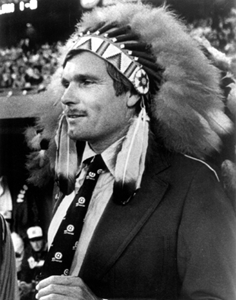
Meet Ted (#2). He never cared what you thought.
Posted by JD Hull at 11:50 PM | Comments (2)
October 29, 2014
November 16: NYC screening of "The Life and Mind of Mark DeFriest", a film about criminal justice.
If you are criminal defense lawyer, this will interest you. Other screening locations, which include law schools, are below. The NYC screening of Gabriel London's documentary "The Life and Mind of Mark DeFriest" is November 16, 9:30 pm, The SVA Theater, 333 W. 23rd Street. About this film:
See the NYC premier of Gabriel London's 's acclaimed film at DocNYC. Bring friends who are interested in the criminal justice system, and of course lawyers, judges, prosecutors, mental health professionals and the like. Gabriel's film captures the humanity of a non-violent but mentally ill prisoner, Mark DeFriest, jailed for a non-crime, who has been denied treatment and punished with rape, beatings, and solitary confinement for 33 years, but still preserves his decency and his sense of humor. Come to the premiere and join the effort to gain a fair parole hearing for Mark, who represents an estimated quarter million mentally ill persons behind bars in the US. Click here for NYC and screening in other cities.
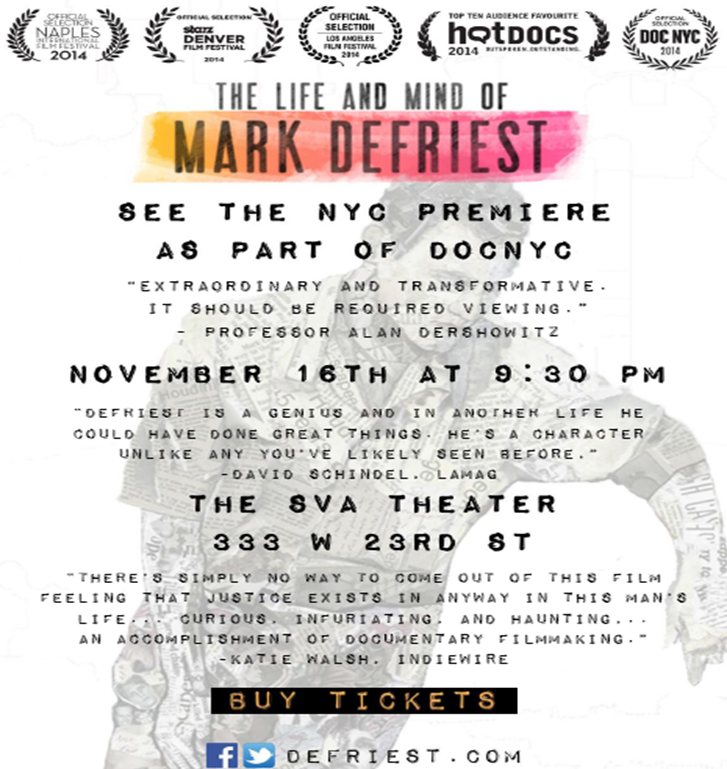
Posted by JD Hull at 01:46 PM | Comments (0)
Over-Communicate: Bombard, Copy and Confirm.
Over-Communicate: Bombard, Copy Confirm. It's from our annoying but dead-on accurate 12 Rules. And it's short.
Rule Five: "Over-Communicate": Bombard, Copy and Confirm
I am indebted to Jay Foonberg for the inspiration for Rule 5--both "bombarding" and the idea of keeping clients continuously informed. Nearly all of my better thoughts about practice management are influenced by Foonberg. The notion of "bombarding" clients with paper and information does have obvious exceptions. For instance, you work with a GC who trusts you and wants you to leave her alone. She doesn't want you to copy her on every transmittal letter or e-mail. Fair enough. Just be 100% sure you know what she wants and doesn't want. But aside from that, this is a "can't miss" rule--and I am amazed that many good lawyers express surprise that my firm informs the client of everything at each step of the way, and copies our clients on everything.
Again, our eternal debt to Jay Foonberg, who had a birthday this week, for this rule. We just changed the words a bit. Happy Birthday to the first lawyer we know to sit down and think about how clients think.
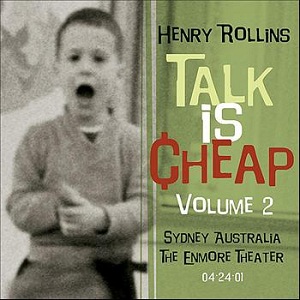
Over-Communicate--but keep it short and don't spazz it up.
Posted by JD Hull at 12:52 AM | Comments (0)
October 28, 2014
Germans.
The most civilized nations of modern Europe issued from the woods of Germany; in the rude institutions of those Barbarians we [received] the original principles of our present laws and manners.
--Edward Gibbon, The Decline and Fall of the Roman Empire, Chapter IX (1782)
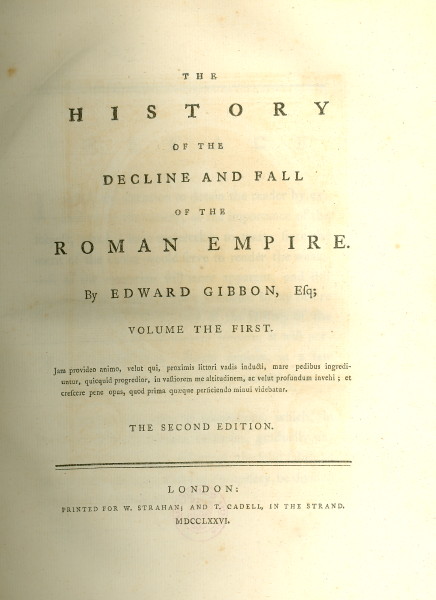
Posted by JD Hull at 05:11 PM | Comments (0)
Daniel O'Connell: The Trial Lawyer as Polymath.
Daniel O'Connell (1775-1847), the "Liberator of Ireland", led a movement that forced the British to pass the Catholic Emancipation Act of 1829, allowing Catholics to become members of the British House of Commons. History knows him as a witty, eloquent and formidable politician, and the Member of Parliament for Clare. The English found him infuriating. But O'Connell was first and foremost a consummate and thorough trial lawyer, called to the bar at age 23 in 1798. As a cross-examiner, one modern writer has said, "he had no equal at the Irish bar." And not surprisingly O'Connell was a bit of a showman. In lectures published in 1901, Prof. John L. Stoddard said of him:
He was a typical Irishman of the best stock--wily, witty, eloquent, emotional and magnetic. His arrival in town was often an occasion for public rejoicing. His clever repartees were passed from lip to lip, until the island shook with laughter.
In court, he sometimes kept the spectators, jury, judge and even the prisoner, alternating between tears and roars of merriment. Celtic to the core, his subtle mind knew every trick peculiar to the Irish character, and he divined instinctively the shrewdest subterfuges of a shifty witness.
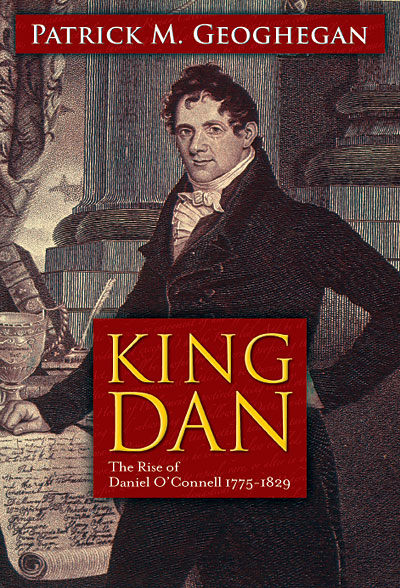
Posted by JD Hull at 10:35 AM | Comments (0)
October 26, 2014
Jack Symon Asher (Jack) Bruce (1943-2014)
Introductory note: What does a Superstar Scot musician's passing have to do with a legal weblog or "blawg" started in 2005 about quality lawyering, the magic of travel, who to fire, who to hire, Paris and making your life a work of art? Everything. If you don't get it, see me after the meeting.
Rock, blues and jazz superstar bassist Jack Bruce died Saturday at his home in Suffolk, England. Classically trained and famously versatile as a musician, Bruce was--among many, many other things in his life and career--co-founder of both Cream and (Leslie) West, Bruce and (Corky) Laing, an exceptional bassist, singer, composer, arranger and producer. He even played the blues harmonica spectacularly. Bruce played with nearly everyone significant in British music. In his first band, which he joined in 1962, his drummer was Charlie Watts. A Scot, musical polymath and quiet madman, Like many other musicians in history, Bruce had a self-destructive streak. He struggled with alcohol and drugs, losing nearly his entire fortune before he stopped using. Bruce was/is several times more interesting than fellow Cream band member and lead guitarist Eric Clapton--and musically just as talented.
Posted by JD Hull at 09:21 PM | Comments (0)
Pantheon: Kim Bassinger, 60.
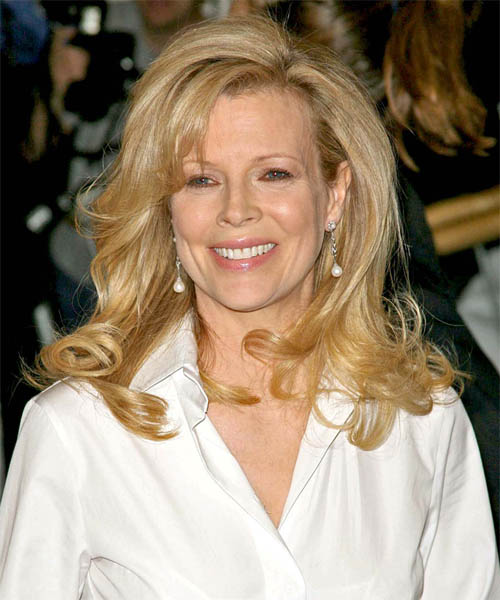
Posted by JD Hull at 05:47 AM | Comments (0)
October 25, 2014
Prisoner of Rock 'n' Roll #2: James, Jones, Cocker & Bassinger.
Go on over there and turn on the light...no all the lights,
Now come back here and stand on this chair...that's right.
Raise your arms up in to the air...shake 'em
You give me a reason to live...--Randy Newman, You Can Leave Your Hat On (1972)
Posted by Holden Oliver (Kitzbühel Desk) at 08:22 PM | Comments (0)
Hate Halloween? Just turn off the lights and lie on the floor.
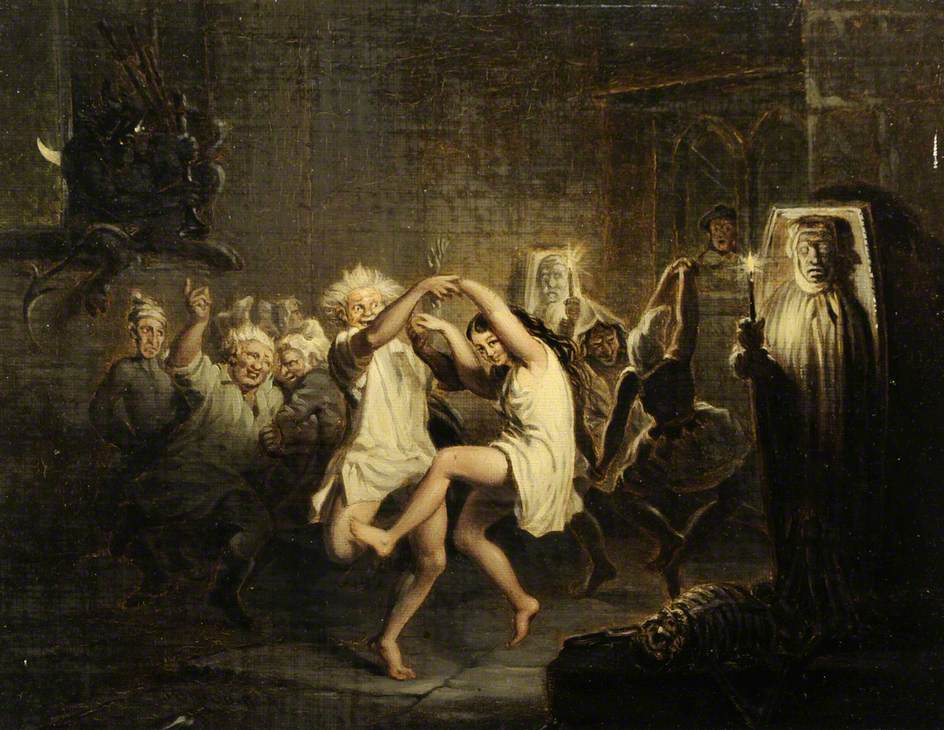
John Faed, Tam O'Shanter and the Witches, 1872.
Posted by JD Hull at 07:39 PM | Comments (0)
Prisoner of Rock 'n' Roll #1: Dancing in small spaces.
Below during the performance of "Rollin' and Tumblin'" at the May 2005 Cream reunion concerts in London, a man in his 30s or 40s dancing in the audience was briefly captured on film for about 12 seconds dancing respectfully and quite well--most humans dance stiffly but this one is on good terms with his own body--in the small space surrounding his seat at the Royal Albert Hall. See 2:32 through 2:45 on the clip. The band playing is not too shabby either.
Royal Albert Hall, May 4, 2005
Posted by Holden Oliver (Kitzbühel Desk) at 03:59 AM | Comments (0)
October 22, 2014
Benjamin Crowninshield Bradlee (1921-2014)
.jpg)
Bradlee with Washington Post owner Katherine Graham in 1971.
Ben Bradlee's death saddens me and many, many other people. In the 1970s and 1980s, Washington Post managing editor Bradlee was an idol to me and most of my friends in college, in Washington, D.C. or in New York when we were writing or editing student dailies, selling our first freelance piece, doing our first jobs with a newspaper or wire service or writing a first book. Bradlee set the standard; he was the standard. He was brave, smart, patrician, demanding, salty, funny and fun.
No one was more dedicated to journalism done right, done under pressure and done both for its art and for the public good. No one was cooler. We felt like we knew him. We wanted to be him.
Last night around midnight, the Washington Post published this comprehensive biography and obituary, written by another Post former managing editor:
Ben Bradlee Dies at 93
By Robert G. Kaiser
Benjamin C. Bradlee, who presided over The Washington Post newsroom for 26 years and guided The Post’s transformation into one of the world’s leading newspapers, died Oct. 21 at his home in Washington of natural causes. He was 93.
From the moment he took over The Post newsroom in 1965, Mr. Bradlee sought to create an important newspaper that would go far beyond the traditional model of a metropolitan daily. He achieved that goal by combining compelling news stories based on aggressive reporting with engaging feature pieces of a kind previously associated with the best magazines. His charm and gift for leadership helped him hire and inspire a talented staff and eventually made him the most celebrated newspaper editor of his era.
The most compelling story of Mr. Bradlee’s tenure, almost certainly the one of greatest consequence, was Watergate, a political scandal touched off by The Post’s reporting that ended in the only resignation of a president in U.S. history.
But Mr. Bradlee’s most important decision, made with Katharine Graham, The Post’s publisher, may have been to print stories based on the Pentagon Papers, a secret Pentagon history of the Vietnam War. The Nixon administration went to court to try to quash those stories, but the U.S. Supreme Court upheld the decision of the New York Times and The Post to publish them.
President Obama recalled Mr. Bradlee’s legacy on Tuesday night in a statement that said: “For Benjamin Bradlee, journalism was more than a profession — it was a public good vital to our democracy. A true newspaperman, he transformed the Washington Post into one of the country’s finest newspapers, and with him at the helm, a growing army of reporters published the Pentagon Papers, exposed Watergate, and told stories that needed to be told — stories that helped us understand our world and one another a little bit better. The standard he set — a standard for honest, objective, meticulous reporting — encouraged so many others to enter the profession. And that standard is why, last year, I was proud to honor Ben with the Presidential Medal of Freedom. Today, we offer our thoughts and prayers to Ben’s family, and all who were fortunate to share in what truly was a good life.”
The Post’s circulation nearly doubled while Mr. Bradlee was in charge of the newsroom — first as managing editor and then as executive editor — as did the size of its newsroom staff. And he gave the paper ambition.
Mr. Bradlee stationed correspondents around the globe, opened bureaus across the Washington region and from coast to coast in the United States, and he created features and sections — most notably Style, one of his proudest inventions — that were widely copied by others.
During his tenure, a paper that had previously won just four Pulitzer Prizes, only one of which was for reporting, won 17 more, including the Public Service award for the Watergate coverage.
“Ben Bradlee was the best American newspaper editor of his time and had the greatest impact on his newspaper of any modern editor,” said Donald E. Graham, who succeeded his mother as publisher of The Post and Mr. Bradlee’s boss.
“So much of The Post is Ben,” Mrs. Graham said in 1994, three years after Mr. Bradlee retired as editor. “He created it as we know it today.”
Leonard Downie Jr., who succeeded Mr. Bradlee as The Post’s executive editor in 1991, said, “Ben’s influence remained very much alive at The Washington Post long after he retired, distinguishing the newspaper and our newsroom as unique in journalism.” President Obama saluted Mr. Bradlee’s role at The Post when giving him the country’s highest civilian honor, the Presidential Medal of Freedom, in 2013: “He transformed that newspaper into one of the finest in the world.”
Mr. Bradlee’s patrician good looks, gravelly voice, profane vocabulary and zest for journalism and for life all contributed to the charismatic personality that dominated and shaped The Post. Modern American newspaper editors rarely achieve much fame, but Mr. Bradlee became a celebrity and loved the status.
Jason Robards played him in the movie “All the President’s Men,” based on Bob Woodward and Carl Bernstein’s book about Watergate. Two books Mr. Bradlee wrote — “Conversations With Kennedy” and his memoir, “A Good Life” — were bestsellers. His craggy face became a familiar sight on television. In public and in private, he always played his part with theatrical enthusiasm.
“He was a presence, a force,” Woodward recalled of Mr. Bradlee’s role during the Watergate period, 1972 to 1974. “And he was a doubter, a skeptic — ‘Do we have it yet?’ ‘Have we proved it?’ ” Decades later, Woodward remembered the words that he most hated to hear from Mr. Bradlee then: “You don’t have it yet, kid.”
Mr. Bradlee loved the Watergate story, not least because it gave the newspaper “impact,” his favorite word in his first years as editor. He wanted the paper to be noticed. In his personal vernacular — a vivid, blasphemous argot that combined the swearwords he mastered in the Navy during World War II with the impeccable enunciation of a blue-blooded Bostonian — a great story was “a real tube-ripper.”
This meant a story was so hot that Post readers would rip the paper out of the tubes into which the paperboy delivered it. A bad story was “mego” — the acronym for “my eyes glaze over” — applied to anything that bored him. Maximizing the number of tube-rippers and minimizing mego was the Bradlee strategy.
Mr. Bradlee’s tactics were also simple: “Hire people smarter than you are” and encourage them to bloom. His energy and his mystique were infectious.
“It was hard to explain the full force of his personality to people who never met him,” said Ward Just, the reporter-turned-novelist whom Mr. Bradlee sent to cover the Vietnam War for The Post in 1966-1967. “He really was one of those guys you’d take a machine-gun bullet for. You only meet three or four of them in an entire lifetime.”
But his strengths sometimes became weaknesses. The editor who could inspire his troops to do some of the best journalism ever published in America also fell for an artful hoax by a young reporter, Janet Cooke. Cooke invented an 8-year-old heroin addict named Jimmy and wrote a moving story about him. After the story won the Pulitzer Prize in 1981, Cooke was exposed as an impostor who invented not only Jimmy but also her own life story.
When they realized that Cooke had concocted an imaginary résumé, Mr. Bradlee and his editors interrogated her and extracted a confession. Mr. Bradlee quickly returned the Pulitzer, then encouraged The Post’s ombudsman, Bill Green, to investigate and report how the incident could have happened. This was the biggest assignment ever given to the in-house reader’s representative. Mr. Bradlee had created the position in 1970, making The Post the first major paper to employ an independent, in-house critic.
Green produced a detailed, embarrassing report about a newsroom where the urge for journalistic impact overrode several experienced reporters’ doubts about Jimmy’s existence. “Bradlee was really hurt” by the Cooke affair, recalled Peter Silberman, who served under Mr. Bradlee as a senior editor.
Mr. Bradlee had a notoriously short attention span. He rarely dug into the details of an issue himself, leaving that to the people he had hired. He managed The Post newsroom with a combination of viscera and intellect, often judging people by his personal reaction to them. He or she “makes me laugh” was perhaps Mr. Bradlee’s greatest compliment. He never enjoyed the minutiae of management and spent as little time on administrative work as he could get away with.
But Mr. Bradlee coped successfully with many crises. “Ben’s famous drive for a good story makes it easy to overlook his good judgment on matters ranging from national security to personal privacy,” observed Boisfeuillet Jones Jr., who was The Post’s lawyer when Mr. Bradlee was editor and who later became publisher.
Although he graduated from St. Mark’s School and Harvard University, the Navy left as much of a mark on Mr. Bradlee as did his early life among Boston’s WASP aristocracy. The Navy taught him to swear, as well as to respect talent wherever it appeared.
He made friends easily with important people — his most famous friend was John F. Kennedy — but he also had pals among printers at The Post and farmers in Southern Maryland, where he spent weekends at his country estate for many years.
He and his third wife, the writer Sally Quinn, loved to give parties at their big Georgetown house. In his 80s, Mr. Bradlee still caroused energetically with people 30 and 40 years younger, amazing his old friends. “He gave a whole new meaning to ‘over 80,’ ” Don Graham said.
Mr. Bradlee’s wartime experience left him an unabashed patriot who bristled whenever critics of the newspaper accused it of helping America’s enemies. He sometimes agreed to keep stories out of the paper when government officials convinced him that they might cause serious harm. But he also reacted angrily to what he considered phony attempts to invoke “national security” by officials who were really just trying to avoid embarrassment.
Lying, especially lying by public officials, particularly offended Mr. Bradlee. He wrote and lectured on the subject for decades.
“The values that Ben instilled in our newsroom — independence and fairness, aggressive reporting, compelling writing and individual initiative — will long outlive him,” Downie said. “And it will always be a newsroom where everyone has fun, as Ben did.”
Mr. Bradlee’s relationship with Mrs. Graham was critical. She allowed him to spend money, ultimately many millions of dollars, to build a great newspaper. At key moments — particularly the 1971 decision to publish excerpts from the Pentagon Papers and later during Watergate — she stood squarely behind him, defying the advice of her attorneys and business advisers and her powerful Washington friends.
Mr. Bradlee “was just what Kay needed — somebody who built her confidence and worked hard at it,” said the late Philip L. Geyelin, who was editor of The Post’s editorial page from 1968 to 1979. “He made her comfortable. He called her up and told her dirty jokes and told her the latest skinny. It was a wonderful relationship. I can’t remember any time they had any quarrel. She was nuts about him.”
Mrs. Graham had said as much herself. In one of the end-of-year letters she and Mr. Bradlee came to exchange annually — warm, intimate notes of mutual appreciation — she wrote: “Over the years, I have been spoiled by you and I hope most of the time, it’s been reciprocated, in sharing the best, most productive, rewarding working combo that I’ve had or even know of. And best of all, it’s been fun.”
She also teased him sometimes and criticized his erratic management of the newsroom, including impetuous hiring decisions that sometimes turned out badly. One year, she sent him a list of 15 names, his hiring “mistakes,” as she called them, and asked how he could avoid such errors in the future. But mostly she sang his praises, as in her end-of-1974 letter to Mr. Bradlee: “The things [about you] that people don’t know — that I know — are style, generosity, class and decency, as well as an understanding of other people’s weaknesses.”
When Mrs. Graham died in July 2001, Mr. Bradlee spoke at her funeral. “She was a spectacular dame, and I loved her very much,” he said, looking down on the vast crowd from the lectern at the east end of Washington National Cathedral. Walking back to his pew, Mr. Bradlee took a slight detour to pass her coffin and give it an affectionate pat.
Benjamin Crowninshield Bradlee was born into the old aristocracy of white, Anglo-Saxon, Protestant Boston on Aug. 26, 1921. His father, Frederick Josiah Bradlee Jr., known as “B,” could trace his American ancestry back through 10 generations of Bradlees. B was an all-American football star at Harvard who became an investment banker in the booming 1920s. He married Josephine deGersdorff, daughter of a prominent New York lawyer and a New England aristocrat named Helen Crowninshield.
Benjamin was the second of three children. At first, he was surrounded by domestic staff and other signs of wealth, but the stock market crash of 1929 ended all that. During the Great Depression, his father had to improvise a living for many years, keeping the books for various clubs and institutions and supervising the janitors at the Boston Museum of Fine Arts (for $3,000 a year). The family had free use of a summer house in Beverly, Mass., whose owners couldn’t find a buyer for it. Rich relations paid the Bradlee children’s tuition to private schools.
“Benny,” as the family called him, was a 14-year-old ninth-grader at the venerable St. Mark’s School in Southboro, Mass., when polio broke out at the campus in the spring of 1936. He was stricken with the fearful disease on the same day as a close friend. An ambulance that carried both boys dropped Mr. Bradlee at his Beacon Street home, then took Fred Hubbell to Massachusetts General Hospital. Mr. Bradlee was paralyzed from the waist down; Hubbell died.
Even his polio proved to be an example of Mr. Bradlee’s lifelong good luck — bolstered, as usual, by his own determination. A young coach who had encouraged Mr. Bradlee’s athletic pursuits, a working-class Irishman from Boston named Leo Cronan, visited him in the Beverly house almost nightly during his summer with polio.
Cronan introduced the idea of walking again at a time when Mr. Bradlee’s legs lay helpless and numb in clunky metal braces. Cronan got him on his feet and then helped him learn how to stand without the braces. Within eight weeks, thanks to rigorous rehabilitation, Mr. Bradlee was playing a clumsy game of golf. Two years later, he was playing varsity baseball for St. Mark’s. The physical therapy he did to fight off the effects of polio left him with a barrel chest and powerful arms for the rest of his life.
Mr. Bradlee got his first whiff of the newspaper business at age 15, when his father arranged a job for him as a copy boy on the Beverly (Mass.) Evening Times. He could augment his $5-a-week salary by reporting events in the lives of local citizens, which he loved to do. “I learned a vital lesson: People will talk if they feel comfortable,” Mr. Bradlee wrote in “A Good Life.”
He was the 52nd male Bradlee to enter Harvard since 1795 — “no alternatives were suggested, or contemplated,” he wrote. He arrived at Harvard Yard just as war in Europe was beginning and decided to join the Naval ROTC to improve his initial posting in the war he and his contemporaries knew they would soon be fighting. With that threat hovering over him, Mr. Bradlee found it hard to be serious about college. Only in his third year, with the war ever more ominous, did he buckle down.
He took a double academic load, which, after summer school, allowed him to graduate in August 1942 with majors in Greek and English. On the same day he received his diploma and his naval commission, Mr. Bradlee married his college sweetheart, Jean Saltonstall, a member of one of Massachusetts’s best-known families. After a short honeymoon, just as he was turning 21, he was off to war.
Mr. Bradlee’s three years in the wartime Navy had a lasting influence on him. As a young officer, he learned empathy for the enlisted men and developed a style of leadership that he relied on throughout his professional life. As recounted in his memoirs, it combined an easy authority with tolerance for the irrepressible enthusiasm of those under his command. Even as a young officer, he never enjoyed a confrontation and preferred accommodation to the aggressive use of authority.
After the war, Mr. Bradlee got his first real job in journalism, working with a St. Mark’s friend, Blair Clark, to create the New Hampshire Sunday News. Mr. Bradlee was one of seven staff members who filled the 64-page paper every week. The editor, Ralph M. Blagden, “had an almost contagious sense of how to find a story and where it might go,” Mr. Bradlee wrote in his memoirs. “For every answer we gave him, he had 50 more questions, and I learned everything from him in two years.”
But the Sunday News couldn’t make money, and it failed. Family friends offered to help Mr. Bradlee find a new job. Edward A. Weeks, the editor of the Atlantic Monthly, wrote a friend at the Baltimore Sun about Mr. Bradlee; Christian A. Herter, the congressman and former governor of Massachusetts, wrote to The Post. In November 1948, Mr. Bradlee set out on a train trip, bound from Boston to Baltimore to Washington to Salt Lake City to Santa Barbara. When his overnight train reached Baltimore, a heavy rainstorm discouraged him from getting off, so he decided to go first to Washington. The day before he arrived for an interview, a Post reporter had quit unexpectedly, creating a vacancy. Mr. Bradlee charmed The Post’s editors, who offered him a job for $80 a week, starting on Christmas Eve.
In his first days at the paper, he impressed The Post’s managing editor, J. Russell Wiggins, by producing a list of the city’s 10 leading bookies. He didn’t tell Wiggins that he got the names from Morris Siegel, his new pal, who was a Post sportswriter. Mr. Bradlee covered the municipal court, the attempted assassination of President Harry S. Truman by Puerto Rican nationalists, the gambling industry in Washington and life in the city’s alleys, still home to tens of thousands of poor African Americans.
He liked The Post, but he wanted to cover big national stories, and it was clear to him that he wouldn’t get a chance to do that for years. The Post, which Mrs. Graham’s father, Eugene Meyer, had bought at a bankruptcy auction in 1933, was still losing money, $1 million a year in 1951. Mr. Bradlee concluded that the paper would not be growing anytime soon. So when an old friend said he could help him become the press attache at the American Embassy in Paris, he jumped.
Mr. Bradlee loved life in Paris, but he was not a natural diplomat or bureaucrat. After 21 / 2 years, he found a way to return to journalism. Newsweek, then a struggling imitation of Time and owned by Vincent Astor, needed a European correspondent. The magazine’s foreign editor was delighted to discover that Mr. Bradlee’s mother had been a friend of Brooke Astor, the boss’s wife. He got the job.
“The sheer joy and romance of being a foreign correspondent is hard to explain, even harder to exaggerate,” Mr. Bradlee wrote in his memoirs. In four years, he covered wars in Algeria and the Middle East, peace conferences in Geneva, the wedding of Grace Kelly and Prince Rainier in Monte Carlo.
One summer, he and his wife, Jean, joined several couples in renting a huge, old French chateau, where they gave house parties every weekend. One of the guests was an old friend from Washington, Antoinette “Tony” Pinchot Pittman, wife of a Washington lawyer and mother of four young children. She and Mr. Bradlee fell in love on the spot, he recounted, an unexpected turn of events that led to their divorces and their eventual marriage.
Bradlee and his second wife, Tony, with President John F. Kennedy and first lady Jacqueline Kennedy at the White House in 1963. The couples had become friends as Georgetown neighbors. (Cecil Stoughton)
In 1957, Mr. Bradlee and his new wife returned to Washington. As a 36-year-old junior reporter in the capital, Mr. Bradlee began conspiratorial conversations with Osborne Elliott, another well-born WASP, also in his 30s, who was Newsweek’s managing editor. They knew that the magazine was likely to be sold.“One night, after a bad day of brooding and a few shooters, I called Elliott in New York and told him I was damn well going to pick up the phone — it was almost 11 p.m. — and call Phil Graham right then,” Mr. Bradlee wrote in his memoirs. And he did.
Philip L. Graham, publisher and owner of The Post and husband of Katharine Graham, invited Mr. Bradlee over to his home immediately. They stayed up until 5 a.m. talking about Newsweek. Within days, The Washington Post Co. had bought the magazine for $15 million.
This business transaction changed Mr. Bradlee’s life. Ultimately, it made him wealthy: Phil Graham bestowed a considerable block of Washington Post stock on him as a “finder’s fee” for putting him onto the Newsweek deal. The shares Graham gave Mr. Bradlee were eventually worth millions.
Phil Graham decided that once he owned Newsweek, Mr. Bradlee should be its Washington bureau chief. This promotion brought him into the inner sanctum of The Post Co. Mr. Bradlee befriended the Grahams, as well as their attorney and key financial adviser, Frederick “Fritz” Beebe, who soon left his New York law firm to become chairman of The Post Co.
The Post Co. bought Newsweek in March 1961, barely six weeks after the inauguration of Mr. Bradlee’s friend, John F. Kennedy, as president. The two young men (Mr. Bradlee was 39 in early 1961; Kennedy, 43) had been neighbors in the 3300 block of N Street NW, where both bought houses in 1957. They met walking baby carriages through Georgetown with their wives. Soon the couples were having dinner together on a regular basis, and Mr. Bradlee was developing what turned out to be the best source of his career.
Mr. Bradlee’s friendship with Kennedy produced complex feelings that lasted for decades after the president’s 1963 assassination. Mr. Bradlee knew reporters shouldn’t become close friends with politicians. At the same time, Mr. Bradlee loved bright, lively, charming people, and he had great confidence in his own ability to stay straight journalistically in all circumstances. “If I was had, so be it,” Mr. Bradlee wrote in his 1974 bestseller, “Conversations With Kennedy.”
Mr. Bradlee insisted that he never had an inkling that the president was carrying on with numerous other women, from Mafia molls to Mr. Bradlee’s sister-in-law, Mary Pinchot Meyer, Tony Bradlee’s sister. Mr. Bradlee acknowledged that this obliviousness seemed improbable, but no evidence ever emerged to challenge his protestations of ignorance.
This friendship was a journalistic boon to Mr. Bradlee, who received a stream of scoops from Kennedy and his entourage that made him a highly visible figure in the competitive world of Washington journalism. He became a certifiable member of the journalistic elite in a capital city where reporters were just starting to become more glamorous and prominent.
Two deaths in 1963 altered Mr. Bradlee’s life. The first was Philip Graham’s suicide that August, after a struggle with bipolar disorder. Then in November, Kennedy was assassinated in Dallas. A fortnight before his death, the Bradlees had spent a glamorous weekend with the Kennedys at their new retreat in Middleburg, Va.
On Nov. 22, 1963, “life changed, forever, in the middle of a nice day, at the end of a good week, in a wonderful year of what looked like an extraordinary decade of promise,” Mr. Bradlee wrote.
After her husband’s death, Mrs. Graham took responsibility for the family business. By her own account, she assumed that all was well with her newspaper. It was in its ninth straight year of profitability, circulation was growing steadily and its competitive position against the Evening Star improved every year. Alfred Friendly, The Post’s managing editor, who ran the news department, was a close friend whom Mrs. Graham relied on.
But soon she began to hear expert opinions — from James Reston of the New York Times and columnist Walter Lippmann, especially — that her paper was far from as good as it could or should be.
Nineteen months after her husband died, Mrs. Graham invited Mr. Bradlee to lunch. She wanted to find out what his ambitions were. She proposed the 1925 F Street Club, where a female member could pay for lunch by signing the bill without causing a stir. It was the first time she had taken a man to lunch for business purposes, and it began awkwardly.
“All of a sudden,” Mr. Bradlee later wrote, “I heard myself say: ‘If Al Friendly’s job ever opened up, I’d give my left one for it.’ ” In her memoirs, Mrs. Graham recalled the same “picturesque” language. She was noncommittal. But she did tell Mr. Bradlee that she had talked to Lippmann about the idea that The Post might benefit from “an infusion of some sort from outside.” That was enough to give Mr. Bradlee “a tingle of excitement in my arms and legs. Lippmann was my pal.”
Why? “Because my mom and his second wife were in Miss Chapin’s School together in New York. They were joint holders of the high-jump record,” Mr. Bradlee replied in an interview for this article in 2000. Lippmann had watched Mr. Bradlee grow up and had taken a shine to him.
Several months after that lunch, Mrs. Graham told her editor, J. Russell Wiggins, and Friendly of her interest in Mr. Bradlee. They reacted negatively. Nevertheless, she proposed that Mr. Bradlee join The Post as a deputy managing editor responsible for national and foreign news with the understanding that he would succeed Friendly “sometime.” She told Mr. Bradlee that it would be in a year; Friendly proposed three years. Mr. Bradlee’s appointment was announced July 7, 1965.
That fall, Lippmann and Friendly had lunch together, a meeting Mrs. Graham had suggested so Friendly could hear Lippmann’s criticisms of The Post. But Lippmann used the occasion to tell Friendly that administrative jobs in newsrooms burned people out and that he should consider returning to reporting.
Friendly, shaken, went right from the lunch to Mrs. Graham’s office, asking whether she wanted him to step down. She was stunned by the speed of events but said yes. On Nov. 15, The Post announced that Mr. Bradlee would be the paper’s new managing editor, a title he would hold until 1968, when he was named to the newly created position of executive editor.
In 1965, The Post had a relatively small staff that included no more than a dozen distinguished reporters. Its most famous writer was Shirley Povich, a sports columnist. Its Pentagon correspondent was on the Navy payroll as a reserve captain. The newspaper had a half-dozen foreign correspondents and no reporter based outside the Washington area in the United States. The paper had no real feature section and provided little serious cultural coverage, but it did carry a daily page called “For and About Women.”
Apart from its famous editorial page (including the renowned cartoonist, Herblock), which had challenged Sen. Joseph McCarthy and vigorously promoted civil rights for African Americans, and which remained Wiggins’s domain after Mr. Bradlee’s arrival, the paper generally had modest expectations for itself, and it calmly fulfilled them.
At the outset, Mr. Bradlee decided “to concentrate on the one thing I did know about: good reporters.” He relied heavily on one good reporter at The Post: Laurence Stern, who proved to be his most important sidekick in the early years. Stern was a wry, irreverent intellectual with ambitious ideas for journalism. Mr. Bradlee named him The Post’s national editor.
Mr. Bradlee brought Ward Just to The Post from Newsweek and soon sent him to Vietnam, where he wrote eloquent, gritty dispatches that undermined the Johnson administration’s public optimism about the course of the war in 1966 and ’67. He hired Richard Harwood from the Louisville Courier-Journal, a brilliant and dogged reporter who became one of the most important editors of the Bradlee era. He found George Wilson, a writer for Aviation Week, who became a distinguished Pentagon correspondent. He hired an old friend from Paris, Stanley Karnow, a Time magazine correspondent in Asia, to be The Post’s China watcher, based in Hong Kong.
Mr. Bradlee’s biggest coup, in his estimation, was hiring David S. Broder from the New York Times. He had to get the approval of Beebe, Mrs. Graham’s most influential colleague, to offer Broder $19,000 a year to leave the Times for The Post. Hiring Broder in September 1966, Mr. Bradlee recalled in 2000, “was of course frightfully important, because then outsiders began to say, ‘Oh my God, did they get Broder? Why did they get Broder? What did Broder see there that we don’t know anything about?’”
Soon after he joined The Post, Broder said, “I knew it was heaven for me.” Mr. Bradlee’s Post was fast, loose and fun, and it gave Broder and other self-starting reporters plenty of room to flourish. Laughter and irreverence were crucial ingredients. Mr. Bradlee played favorites, so the people who made him laugh, or who wrote those tube-rippers, agreed that working for him at The Post was a heavenly experience. Those left out of Mr. Bradlee’s magic circle could feel their exclusion with some pain.
Confronted with a staff that included reporters he considered mediocre but who all enjoyed job security, Mr. Bradlee felt he had to encourage some people to leave — by “abusing people,” as he put it in 2000. “That’s what it was — mistreating people, not treating them the way you treated the people you really cared about.” He did it with no pleasure, his words and his body language made clear, but “I did it, to try to get rid of people, to try to persuade people to leave.”
Mr. Bradlee had the reputation of a tough guy. But after that initial period, he avoided confrontations and almost never fired an employee.
The changes he made were not guided by any grand design or elaborate philosophy of journalism. “I was simplistic,” he said in 1991, discussing those early days. “If you made the paper better every day, and you got better people working for you, and you reached higher, the paper would get better.” It was a lesson he said he learned from Miss Fisk at the Dexter School, his private grade school in Boston: “Our best today, our better tomorrow.”
When he came to The Post, Mr. Bradlee did have in mind one departure from the traditional view of daily journalism: “There [was] no reason why you couldn’t do daily what the news magazines were doing weekly,” he said. “On main news events, tell [readers] what it meant as well as what happened, and put it in some kind of historical and social perspective. And as far as the back of the book was concerned [the phrase used at Time and Newsweek to describe the magazines’ feature sections] to tell [readers] what was going on in the cultural divisions of society. And to entertain them. Those magazines were more entertaining than newspapers.”
Post reporters such as Just, Harwood and Nicholas von Hoffman, a daring writer who learned his craft at the old Chicago Daily News, began to write with a confidence and an edge that was seen in the “new journalism” being published in Esquire magazine but was rarely on display in daily newspapers. Broder, Harwood, Haynes Johnson, a Pulitzer Prize-winner from the Evening Star, and their colleagues made The Post the country’s leading chronicler of national politics, Mr. Bradlee’s favorite subject.
In the late 1960s, Mr. Bradlee began work on a new section for The Post that would give the paper a “back of the book” like Time’s or Newsweek’s — a place for cultural news, entertaining stories and journalism about the way people conducted their lives. Mr. Bradlee wanted a section devoted to “how men and women lived — together and apart — what they liked and what they were like, what they did when they were not at the office. We wanted profiles . . . that went way beyond the bare bones of biography. We wanted to look at the culture of America as it was changing in front of our eyes. The sexual revolution, the drug culture, the women’s movement. And we wanted it to be interesting, exciting, different.”
The Style section first appeared Jan. 6, 1969. It was not an immediate hit with everyone. Some female readers missed “For and About Women,” which Style replaced. One of them, at least briefly, was Mrs. Graham, who provoked Mr. Bradlee’s ire with questions and complaints about Style.
“Damn it, Katharine,” he finally blurted out, “get your finger out of my eye. Give us six weeks to get it right, and then if you don’t like it, we’ll talk.” Both said later that this spat improved their relations.
Local news was never a favorite Bradlee topic, but he understood its importance and encouraged the editors and reporters who cared about aggressive coverage of the Washington region. The Post expanded into the suburbs just as they were becoming the dominant force in the regional economy, a critical element in the paper’s successful competition with the Evening Star.
Mr. Bradlee was especially proud of one of the changes he made during his first years at The Post that wasn’t as tangible as a new section of the paper but ultimately might have been more significant. The Post he inherited was intertwined with power in a way that made him uncomfortable. As publisher, Philip Graham had often used his stature and personal charm to meddle in politics and influence events behind the scenes. For example, he encouraged Kennedy and Lyndon B. Johnson to agree to be running mates in 1960. Post editors also sometimes used their power to achieve objectives that were not entirely journalistic.
Mr. Bradlee wanted none of this. He announced a new approach through a series of confrontations with Ben Gilbert, the longtime city editor, who cultivated friendships with city officials. One was Walter E. Washington, a former local and federal housing official who was married in Gilbert’s living room.
President Johnson had decided to name Washington the first black “mayor” of the District of Columbia. Mr. Bradlee first heard about this when he was invited to The Post’s executive dining room to have lunch with two of Johnson’s aides.
“I asked around about what the purpose of the lunch was,” Mr. Bradlee recalled in 1991. “Believe it or not, the purpose was to clear the appointment of Walter Washington with The Post’s hierarchy. And I refused to go to the lunch. . . . And not a goddam word of it has been in The Washington Post!’ . . . I was just determined to get it into the paper.”
Before long, the city staff had prepared a thorough story about Washington’s appointment. Mr. Bradlee ran it on the front page in August 1967. By 1969, Gilbert had left the newspaper.
Watergate made Mr. Bradlee’s Post famous, but the story that probably made the Watergate coverage possible was the Pentagon Papers, initially a New York Times scoop. Daniel Ellsberg, a disaffected former government official, gave the Times a set of the papers, a compilation of historical documents about U.S. involvement in Vietnam. Times journalists worked for months on stories about them, which began to appear June 13, 1971. The stories created a sensation, even though they contained very little dramatic revelation. After three days of stories, the Nixon administration successfully sought a federal court injunction blocking further publication, the first such “prior restraint” in the nation’s history.Ellsberg then offered the documents to The Post. Two days after the court order, Post editors and reporters were plowing through the Pentagon Papers and planning to write about them.
The Post’s attorneys were extremely nervous that the paper might publish stories based on material already deemed sensitive national security information by a federal judge in New York. The Post was about to sell shares to the public for the first time, hoping to raise $35 million. And the government licenses of The Post’s television stations would be vulnerable if the paper was convicted of a crime.
The reporters and editors all believed that The Post had to report on the papers. Mr. Bradlee called one of the two friends he kept throughout his adult life, Edward Bennett Williams, the famous lawyer. (The other long-term pal was Art Buchwald, the humorist. The three regularly ate lunch together, boisterously. Williams died in 1988; Buchwald in 2007.)
After hearing Mr. Bradlee’s description of the situation, Williams thought for a moment and said: “Well, Benjy, you got to go with it. You got no choice. That’s your business.”
Armed with Williams’s judgment, Mr. Bradlee called Mrs. Graham, who was hosting a retirement party for a Post business manager. Beebe was on an extension phone. When Mrs. Graham asked his advice, he tepidly said he didn’t think he would publish. She disagreed. “I say let’s go,” she told Mr. Bradlee. “Let’s publish.”
That moment, Mr. Bradlee wrote in his memoir, “crystallized for editors and reporters everywhere how independent and determined and confident of its purpose the new Washington Post had become.” Defying the government in printing those stories proved that The Post was “a paper that holds its head high, committed unshakably to principle.”
The Post did publish, and did end up in court, with the Times. The Nixon administration argued that publication of stories based on the Pentagon Papers could undermine national security, an argument that infuriated Mr. Bradlee. But the Supreme Court ruled 6 to 3 that the government could not restrain the newspapers.
Eighteen years later, the man who had argued the government’s case before the Supreme Court, former solicitor general Erwin Griswold, admitted in a Washington Post op-ed essay that the national security argument was phony.
“I have never seen any trace of a threat to the national security from the publication” of the Pentagon Papers, Griswold wrote in 1989. Mr. Bradlee loved that article, and he carried a copy in his jacket pocket for weeks afterward.
The sense of independence earned in 1971 was critical to The Post’s pursuit of Watergate, which began the next June. At every stage, it was a compelling yarn, from the days when Woodward and Bernstein established connections between the burglars and President Richard M. Nixon’s reelection campaign to the amazing weeks, more than two years later, when it became clear that the president would not survive in office.
“Newspapering deals with small daily bites from a fruit of indeterminate size,” Mr. Bradlee wrote later. “It may take dozens of bites before you are sure it’s an apple. Dozens and dozens more bites before you have any real idea how big the apple might be. It was that way with Watergate.”
Mr. Bradlee called it “the story that put us all on the map.” Neither he nor The Post was ever the same again. The recognition grew after the movie made from “All the President’s Men” appeared. Mr. Bradlee was relieved that director Alan J. Pakula made a good and essentially accurate movie that seemed to capture the real spirit of The Post and the story.
Mr. Bradlee enjoyed “life on the ladder of fame,” as he described it in his memoirs. Characteristically, he made a pal of Robards as a result of the movie. He had no complaints when glamorous people in Hollywood and New York sought him out.
Mr. Bradlee’s life changed in another important way in the early 1970s. He fell in love with Sally Quinn, a vivacious, high-energy soul mate, 20 years his junior, whom he had hired as a party reporter for the Style section. With no journalistic training or background, Quinn wrote her way into a prominent role at The Post, profiling the mighty and hoping-to-be-mighty of Washington with a sharp eye and sharper pen.
“People were going to be sad again,” Mr. Bradlee wrote in his memoir, a reference to the second family he would break up in two decades, this time to be with Quinn. They moved in together in October 1973, at the height of the Watergate excitement, and were married five years later.
Mr. Bradlee had edited The Post for nearly nine years when Nixon resigned in August 1974. In those years, he had created a great newspaper and made it famous. Nothing that happened in the newsroom in the 17 years he remained as executive editor was as dramatic as the events of those first nine, with one unhappy exception: the Janet Cooke affair in 1981.Cooke’s deception was a jolt for Mr. Bradlee and his colleagues. Personnel management was not one of his strong suits. Female and black reporters had brought formal complaints of discrimination against Mr. Bradlee’s Post, to his great frustration. He thought he was open and fair but didn’t realize that the lack of any reliable system for evaluating journalists and developing their careers made some people feel they weren’t appreciated.
In 1984, at Don Graham’s urging, Mr. Bradlee named Downie managing editor. Downie, 21 years younger than Mr. Bradlee, had won his stripes as an investigative reporter and as an editor on the Watergate story. He was not one of Mr. Bradlee’s favorites and wasn’t his first choice to be managing editor. But he won Mr. Bradlee’s respect, and they were soon working easily together. In 1991, on the eve of his 70th birthday, Mr. Bradlee retired. He still looked and acted like a man much younger.
The staff drenched him in an outpouring of emotion on his last day in the newsroom, July 31, 1991. Most of the men and women on the staff had bought, borrowed or faked a striped shirt with a white collar and cuffs, mimicking those made by Turnbull & Asser in London that Mr. Bradlee had been wearing for years. For tribute after tribute, Mr. Bradlee kept his eyes dry. But then he heard the telegram from Nora Boustany, who had covered the war in Lebanon for The Post and was back in Beirut for a visit at the time of the retirement party. Her comments were read aloud:
“Whenever I found myself alone on the streets of Beirut, I would just shrug off the shelling, the gunmen, and the dark corners, telling myself there is this distinguished eminence up there who really appreciates and understands the true meaning of courage in journalism. . . . For me you will always be the grand, brave man of the news who watched over me and made me want to give just a little bit more. Thank you for giving us all something so special to believe in.”
Don Graham made Mr. Bradlee a director of The Washington Post Co. and a vice president of the newspaper. Graham spent some time coming up with an appropriate title. He chose “vice president at large,” a generous signal that Mr. Bradlee remained a big figure but had no particular responsibilities.
In retirement, Mr. Bradlee wrote his highly successful memoir. He and Quinn raised millions of dollars for Children’s National Medical Center, which had done so much for their son, Quinn, who was born with serious disabilities in 1982. He also gave money away, endowing the Bradlee Professorship of Government and the Press at the Kennedy School of Government at Harvard.
He joined the International Advisory Board of Independent News & Media, a global media company that owns newspapers and other properties in Ireland, England and South Africa. Into his 80s, he enjoyed traveling to board meetings in those countries. Mr. Bradlee also served as chairman of the Historic St. Mary’s City Commission, the nonprofit organization that maintains the historical relics of St. Mary’s, the oldest European settlement in Maryland. In 2007, the French government awarded him its Legion d’Honneur, France’s highest decoration.
Mr. Bradlee and Quinn maintained residences in St. Mary’s County, Md., in East Hampton, N.Y., and in Georgetown. Besides his wife, survivors include a son from his first marriage, Benjamin C. Bradlee Jr. of Boston; two children from his second marriage, Dominic Bradlee of Hydra, Greece, and Marina Murdock of Purcellville, Va.; a son from his third marriage, Quinn Bradlee of Washington; 10 grandchildren; and a great-grandchild.
The late David Halberstam, who won a Pulitzer Prize for the New York Times and devoted much of his book “The Powers That Be” to Mr. Bradlee’s Washington Post, offered this valedictory in an interview:
“He took The Post, then affluent and filled with underutilized potential, and made it a formidable national newspaper worthy of a head-to-head competition with the [New York] Times. He did it in a way that made the paper itself a joyous place to work. The paper reflected his personality. He was exuberant, competitive and combative if challenged. He made The Post a magnet for young reporters looking for a chance to play in a very high-stakes game.”
Robert G. Kaiser is a former managing editor of The Washington Post.
Posted by JD Hull at 11:34 PM | Comments (0)
October 21, 2014
Pantheon: Nico

Born Christa Päffgen in Cologne (1938-1988)
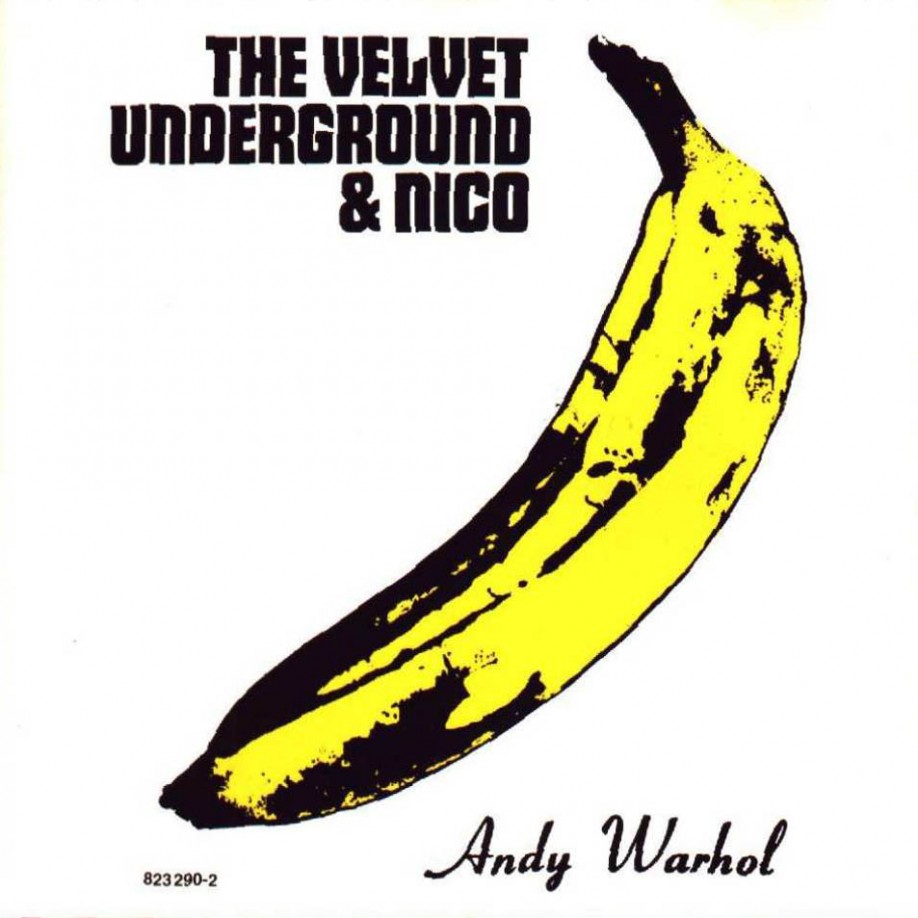
Posted by JD Hull at 12:38 PM | Comments (0)
"It's nice to be Dr. Ruth..."
Long story, but yesterday morning I had breakfast here in New York with Ruth Westheimer (Dr. Ruth) who at 86 is just one month older than my own Mom and just as sharp and vibrant. I met her about 10 years ago and see her every 2 years or so--but I never really talked her longer than a couple of minutes before yesterday. She is funny and classy and bawdy all at once.
And, as I told her in the middle of breakfast, she's got big ones.
Google Dr. Ruth some time.
She was born in Bavaria in 1929. Just a few months older than Anne Frank, she lost both parents in the Holocaust after they were taken from her in 1941, but did not really learn of their deaths until 1945. She escaped the Nazis and spent her early teen years in a Swiss orphanage. She was trained and served as a scout and sniper in the late 1940s after moving to Palestine. That career was cut short when she was seriously injured by a shell in the 1948 Israeli War of Independence. She spent months in the hospital. She speaks four languages (including Hebrew) but spoke no English when she arrived in NYC in the mid-1950s. She has lived in the same Washington Heights apartment for 50 years. She has been married 2 times and has been widowed since 1997. She has kids and grandkids. She is a single mother, survivor, winner, dreamer and doer. A problem solver.
And a joy to be around. I gather that she is totally incapable of feeling sorry for herself, even for a minute.
She is 4' 7" in height. That's right. 4 feet 7 inches.
An off-Broadway play about her is still running.
And she is precocious and funny. Yesterday a waiter recognized her and eagerly offered to go to the buffet for her almost as soon as we entered the dining room and before we even sat down. She quickly but graciously allowed him to do so--and then gave the star-struck waiter and fan her food preferences. Off to the buffet he went. She smiled mischievously and said: "It's nice to be Dr. Ruth."
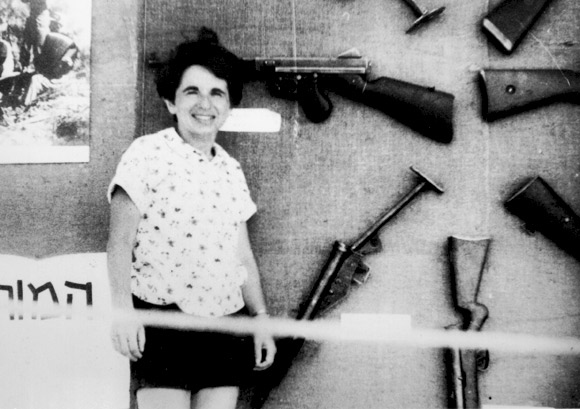
Posted by JD Hull at 10:43 AM | Comments (0)
October 20, 2014
H.G. Wells on Editors.
No passion in the world is equal to the passion to alter someone else's draft.
--H.G. Wells (1866-1946)
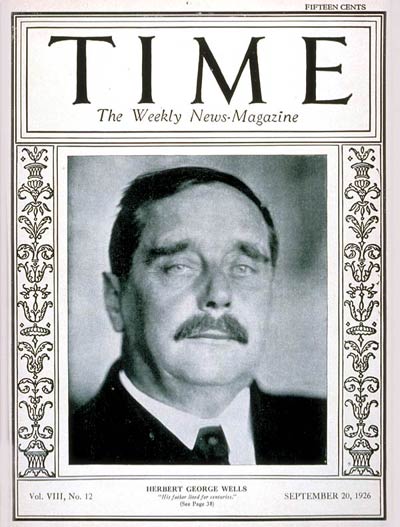
Posted by JD Hull at 12:59 AM | Comments (0)
October 19, 2014
The Headless Horseman Pursuing Ichabod Crane, 1858, by John Quidor
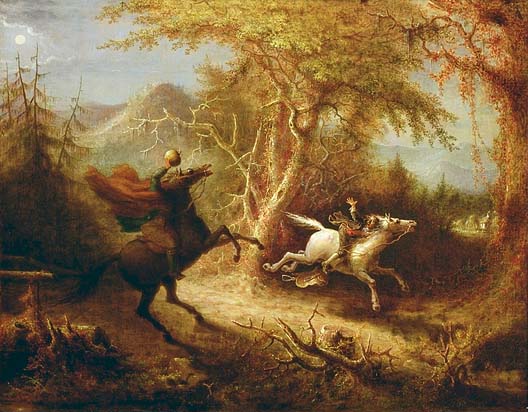
The Headless Horseman Pursuing Ichabod Crane, 1858, by John Quidor (1801-1881) Smithsonian, Washington, D.C.
Posted by JD Hull at 11:00 PM | Comments (0) | TrackBack
Answering Interrogatories.
A couple of years ago, my friend and Renaissance man Ray Ward at his superb the (new) legal writer flagged a nicely done nuts-and-bolts resource for answering written interrogatories by Manhattan's Judge Gerald Lebovits which appeared in the January 2012 New York State Bar Association Journal.
What? You've seen this post before?
Good. It's one of our many "evergreen" pieces on working and practicing law. We will post it again and again until maybe we start hearing and reading reports that exemplary standards and uncannily high quality lawyering are taking over the profession--and it's all that clients, GCs, lawyers, judges and law school profs ever talk about.
Posted by JD Hull at 12:37 AM | Comments (0)
October 18, 2014
Has the NRDC Gone Hollywood?

NRDC's Hinerfeld: "They win lawsuits."
Several years ago, I wrote "Has the NRDC Gone Hollywood?" at the request of Environmental Protection Magazine, where I had a bi-monthly column and feature commitment. Based on my trip to the Robert Redford house in Santa Monica, California, and my interviews with environmental activists and strategists with offices there, "Has the NRDC Gone Hollywood?" is about white-hat environmental attorneys at the Los Angeles office of the well-regarded Natural Resources Defense Council, a national public interest lobby now in its 45th year. I'm told the piece is still hip and funny. We are not certain if it was ever linked to by this blog. So I am sharing this with you now.
Has the NRDC Gone Hollywood?
By J. Daniel Hull
SANTA MONICA, Calif. -- Daniel Hinerfeld, the young, ultra-articulate director of communications for the Southern California office of the Natural Resources Defense Council ("NRDC"), agreed to let me drop by in mid-September to interview him and some other NRDC staffers so I could write this installment.
I was slightly nervous about visiting. It was a little unseemly, I thought, for me to mingle brazenly with the Los Angeles office of the smartest, hippest, and arguably most successful public interest group in the world. I grew up in the Midwest, and as an environmental lawyer, I have represented chiefly companies -- some quite large and many of them processors, transporters, or storers of fossil fuels.
While several clients have been laudably progressive in their environmental quality management, more than a few of them allegedly violated their National Pollution Discharge Elimination System permits or were driven into consent orders under the Clean Water Act, Comprehensive Environmental Response, Compensation, and Liability Act, or Resource Conservation Recovery Act.
Plenty troubling was one ex-client: an operator of 50 underground storage tanks outside of Pittsburgh with a history of alleged groundwater contamination violations and a compliance program which, in the good years, consisted of sporadically checking properties to see if the ground had caught fire.
So, I wasn't really sure if I had the cultural, political, or professional qualifications to visit the NRDC's Los Angeles office and write this article. But the energetic Hinerfeld was quick to point out that, as a single issue, protection of the environment often transcends politics and culture wars.
"It's really a bi-partisan issue," he noted. "Everyone wants clean air and clean water." Hinerfeld, of course, is right. Although it's true that environmental compliance costs on occasion have put good companies out of business and good people out of jobs, strictly speaking, we all -- Republicans, Democrats, Independents, whatever -- want a healthy planet.
Aggressive Lawyering
Another thing I have in common with the NRDC is the legal profession. Among other things, the NRDC is a boutique law firm of lawyers who practice only environmental law.
"They win lawsuits," Hinerfeld said matter-of-factly, and he's right about that, too. In fact, in its 35 year history, the NRDC has surpassed all other political action, citizens', and trade groups in "pro-environment" victories and accomplishments -- many of them through litigation. John Adams, the NRDC's president, is a lawyer himself who, in 1970, co-founded the organization in New York City following a five-year stint as an assistant U.S. attorney for the Southern District of New York.
Under Adams's leadership, the NRDC has grown steadily and now has more than 600,000 members and a permanent staff of nearly 300, including lawyers, scientists, and research assistants. There are about 60 lawyers in the NRDC's four offices. Since the 1970s they have filed scores of cases out of the New York, Washington, D.C., San Francisco, and Los Angeles offices. Many are enforcement actions, based on the "citizen suit" provisions of the major federal environmental statutes or their state counterparts -- filed when the government lacks either the will or resources to act. For years, the NRDC has monitored industry compliance with NPDES permits and often sues dischargers exceeding their parameters under Section 505 of the Clean Water Act -- the citizen suit provision. The NRDC has filed amicus briefs -- briefs filed with the court by people or entities who are not parties to a lawsuit -- and comments in literally hundreds of lawsuits and rulemakings under federal and state statutes.
Two recent clean water cases are illustrative. In 1994, the NRDC Southern California office sued the California Department of Transportation (Caltrans) to require the agency to address, among other things, stormwater violations resulting from run-off on highways in southern California. In 2004, Caltrans finally agreed to a consent order which could cut 80 percent of the stormwater pollution coming from state highways.
In 2003, the NRDC in New York served notice of its intent to sue Occidental Petroleum and Maxus Energy for pollution to the Newark Bay in New Jersey. In a matter of months, Occidental and Maxus entered into a consent order with the U.S. Environmental Protection Agency -- which had previously failed to act on the matter -- requiring a full investigation and cleanup of the bay. The NRDC is closely monitoring compliance with that order.
A Public Interest Group with Everything?
The NRDC's mission statement begins by declaring its "purpose is to safeguard the Earth: its people, its plants and animals and the natural systems on which all life depends." Its slogan is "The Earth's Best Defense." These are very tall orders. To its credit though, the NRDC covers, in depth, a remarkably broad range of environmental areas in its now international watchdog-enforcer role: limiting oil and gas development in the Rocky Mountains; protecting Appalachian streams from coal waste; advising Chinese officials on energy efficiency; identifying environmental health risks in Latino communities; global warming; endangered species protection; nuclear waste disposal; cross-border pollution; pesticide control; preserving open space in cities; protection of marine life -- and even nuclear weapons policy.
It's got money, too. According to its 2004 Annual Report, the NRDC has an operating budget of close to $55 million. In 2004, it raised about $67 million -- $45 million from its 600,0000 members and other individuals. Grants, investment income, and legal fees won in lawsuits (about $570,000 in FY2004) accounted for the remaining $22 million. And speaking of resources, the NRDC's Board of Trustees is definitely interesting. Along with the usual captains of industry, power lawyers, and academics you usually see on the board of a major charity are names of the Hollywood elite: Laurie David (Seinfeld creator Larry David's wife); Elizabeth Wiatt (wife of William Morris Agency chief James Wiatt); Warner Brothers President Alan Horn; Peter Morton (of Morton's restaurants and founder of Hard Rock Cafes.); and three entertainers who have been serious NRDC supporters for years: singer James Taylor and actors Leonardo DiCaprio and Robert Redford.
The Greenest Building in America
Which brings us to the NRDC's Southern California office. It's housed in "The Robert Redford Building," which is billed as the "greenest building in America." I don't know any artful way to say this, so I'll just blurt it out: The Robert Redford Building in Santa Monica is the coolest and best thought-out building I've ever seen or been in and you should just go see it. Located at 1314 Second Street, and formerly a 15,000 square foot "acupuncture institute" (remember, we're in L.A.), the building is a few blocks from the Pacific Ocean and the Santa Monica Pier. (Twice weekly, NRDC offers tours, and a virtual tour is available at www.nrdc.org; click "Cities and Green Living").
For starters, the building is beautiful and quietly elegant. The exterior of the building has an understated classical design to survive changes in building styles over the next few decades. The siding is a wood substitute made of cement and sawdust that, unlike wood, won't shrink or expand, requiring far less maintenance over the years. The interior has tastefully decorated offices, conference rooms, and even a working rooftop terrace in light browns, pastels, and off-white colors. Wood for flooring and furniture is processed without toxic chemicals.
The building uses less than 60 percent of the energy that a typical U.S. office of the same size does. It produces no carbon dioxide emissions (a global warming element). Electricity is produced from rooftop solar panels and "wind certificates" representing electricity purchased from off-site windmills.
The Redford building also funnels rainwater to a treatment facility and recycling system in the building's basement, conserving water and preventing the building's stormwater run-off from polluting the Santa Monica Bay. Rainwater not captured for use in the system is used to irrigate plants and recharge underground water supplies. Two huge cisterns hidden beneath planters can catch and store about 3,000 gallons of rainwater. The rainwater, coupled with recycled water from showers and sinks, helps reduce outside water consumption by 50 percent. The building's recycling system can process 800 gallons of water per day.
Every detail of the building (too many to list here) is designed to conserve, sustain, and/or protect. The rooftop terrace is grooved to allow rainwater to drain to the two cisterns. Even the carpet is chemically "environmentally correct." The chairs in the large rooftop conference room have solid maple frames with seats woven from recycled seatbelts left over from auto manufacturers' purchase orders.
After it was purchased, $1.3 million in design and other preliminary costs were spent on the building. Construction costs for the building were $3.8 million -- or about $253 per square foot. The names of the handful of large donors who built the Redford building hang on a plaque inside the front door. They include the Horns, the Davids, Peter Morton, Leonardo DiCaprio, and the Wiatts.
Dedicated, Smart
The only thing more impressive than the building is the NRDC staff. No matter what your politics, you have to like and respect them. I met a few of them.
David Beckman, an NRDC lawyer who works on water issues, left a large law firm to join the NRDC. Beckman, a graduate of Harvard Law School who can clearly work as a lawyer wherever he wants, was instrumental in the success of the Caltrans stormwater challenge. He also helped coerce an agreement four years ago between 25 northern California litigation districts, the U.S. Bureau of Reclamation, and the NRDC to facilitate restoration of the San Joaquin River through water contracts for farmers of California's Central Valley. Without the agreement, the San Joaquin, California's second longest river, would continue to dry up and further threaten fish populations. Cara Horowitz, another lawyer just out of school, works in the NRDC's ecosystems team on marine mammal issues; her job includes litigation against the U.S. Navy over the harm to whales, dolphins, and other marine life caused by high-intensity active sonar. Horowitz graduated from Yale and then attended law school at the University of California at Los Angeles, where she was first in her class. She is also a former clerk to a judge on the U.S. Court of Appeals for the Ninth Circuit.
Like Beckman and Horowitz, Hinerfeld himself is as talented as he is dedicated. He's an alumni of Vassar, London School of Economics, and National Public Radio. Under Hinerfeld's supervision, the L.A. office even commands a page or two on the environment in each issue of Los Angeles Confidential, an expensive, hyper-slick quarterly "vanity" magazine where you're way more likely to find photos of Warren Beatty or Darryl Hannah at L.A. parties and reports about who's and what's hot in Hollywood than you are to see reports on endangered shrimp species, a "Heal the Bay" update, or conservation tips to save the planet.
Does the NRDC Use Hollywood to Get Its Point Across?
It sure does, and the city gladly obliges. One reason may have less to do with money than publicity. While it's true that the Redford building is a very short drive in your Mercedes or Bentley from some of the wealthiest suburbs in the world, the NRDC knows that if Julia Louis-Dreyfus, a Seinfeld regular and NRDC mainstay, announces a press conference on an upcoming educational or fundraising event for clean water or fuel efficiency issues, two good things often come of it: the kind of media attention that only stars or politicians can bring, and, okay, the money.
According to Hinerfeld, some NRDC celebrities are anything but mere figureheads or fundraisers on environmental issues. Several know the issues inside and out and have donated extraordinary amounts of time over the years. Robert Redford, who grew up in Santa Monica, has worked quietly and continuously with the NRDC and its founder John Adams on substantive issues since 1970.
According to Hinerfeld, Redford's projects include early lobbying for key modern environmental legislation, helping block oil drilling in the Arctic Wildlife Refuge, stopping the construction of a coal-fired plant near five national parks in Utah, and hosting a U.S.-Soviet Union summit on global warming. The NRDC building bears his name to celebrate the Redford-NRDC relationship and Redford's efforts.
Another NRDC stalwart has been singer James Taylor, who has appeared at benefit concerts. Laurie David and Elizabeth Wiatt run the "Earth to L.A." program, an annual pageant (Tom Hanks was Master of Ceremonies in 2004) that has raised millions in the four years since Ms. David started it. Recently, leggy blonde Cameron Diaz became interested in the NRDC's Biogems Initiative, which preserves exceptional lands around the world and protects them from destruction. And if you check out www.nrdc.org, and click on "Clean Water and Oceans," you can see a video of what the raunchy funny-man Jack Black has to say about air and water pollution.
The NRDC's staff is not the least bit uncomfortable with the "special relationship" (in Hinerfeld's words) between the organization and Hollywood. Special Initiatives Director Liana Schwarz, a former Washington, D.C. advance person and political consultant, stays pretty much glued to the phone, courting what she calls her celebrity constituency: DiCaprio, Redford, the Davids, the Wiatts, Black, Diaz, Louis-Dreyfus, Pierce Brosnan, and Ben Stiller.
Why do "Hollywood people" get involved? Hinerfeld suggests it's something more than celebrities wanting to be involved in the gravitas of national political issues. It's highly personal. For the longest time, Los Angeles's smog and particulate matter problems were notorious, and the city's beaches too dirty or contaminated to use. Pride in the ongoing process of cleaning up and preserving the city is a huge factor in keeping its residents pro-environment and pro-NRDC. California, love it or hate it, still has natural beauty in its pristine beach, mountain, forest, and desert areas that nearly all Californians, including the rich and elite, regularly enjoy. And that makes sense. No one here wants a return to the smog-choked city of 20 years ago, which still strives to improve itself.
The NRDC really didn't go Hollywood after all. It just capitalized on the genuine interest many elite Los Angeles people have in environmental issues. Hollywood, though, does seem to have gone NRDC -- and that's indeed hard to knock.
About the Author
J. Daniel Hull is an environmental lawyer, litigator and lobbyist with Hull McGuire PC (www.hullmcguire.com), which has offices in Pittsburgh, Washington, D.C. and San Diego. The firm practices in the areas of environmental law, litigation, legislative affairs, IP, employment practices and international tax and transactions. Mr. Hull can be reached at (619) 239-9400. His blog is at http://whataboutclients.com.
Posted by JD Hull at 11:59 PM | Comments (0)
October 17, 2014
Tarrytown Dutch
Old Dutch Church in Sleepy Hollow, Tarrytown, New York
Posted by JD Hull at 11:57 AM | Comments (0)
Photoshop This: Say it ain't so, Tom Corbett.
Since 2011, a former law partner of mine, Tom Corbett, a first-rate trial lawyer and past U.S. Attorney, has been the Republican governor of Pennsylvania. Not bad, considering that Pennsylvania, like its neighbor New Jersey, has been steadily morphing from GOP to Democratic in the last 25 years. In the November 2010 election, Corbett was able to take control back from Democrats, who had enjoyed 8 years under the popular Ed Rendell. Now running for his second term in a close race, Corbett is again hardworking and people-savvy as a campaigner. He generally picks topflight staff for everything. So he is way too smart to let this happen, via the Philadelphia Daily News: "Smiling black woman next to Corbett on his website was Photo-shopped." According the Corbett campaign, others in the offending image were photoshopped, too. Not the best damage control, either, guys. Finally, not too good picture of you, Governor. Bad week, I'd say.
.jpg)
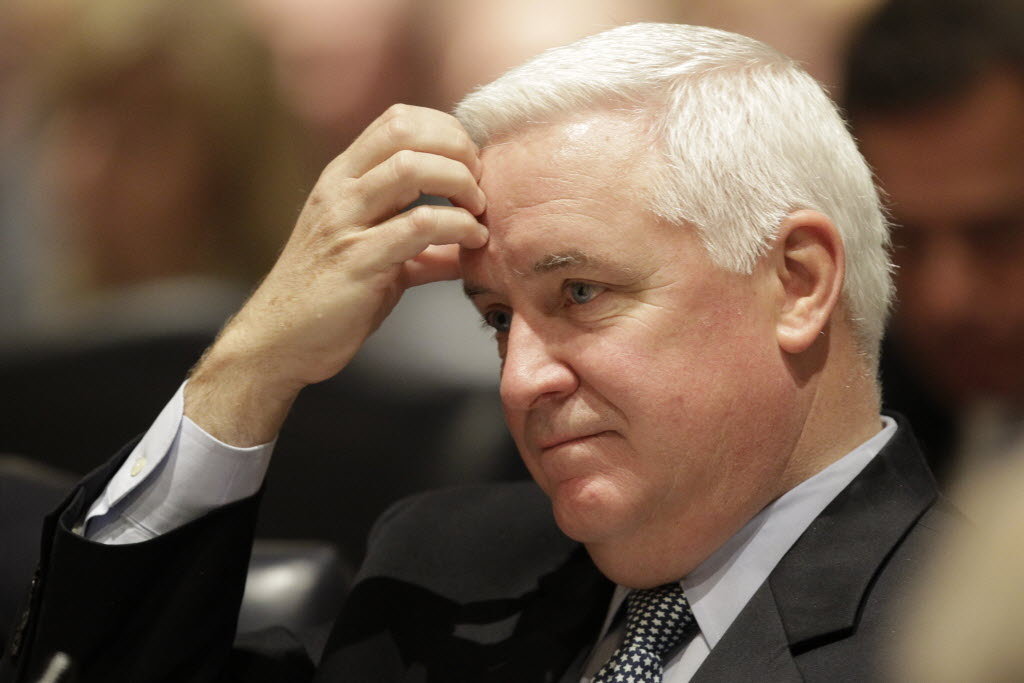
Posted by JD Hull at 10:37 AM | Comments (0)
October 15, 2014
October 15, 1764
On this day in 1764, Edward Gibbon, historian and Member of Parliament, saw friars singing in the ruins of the Temple of Jupiter in Rome. The experience inspires him to write what would become the controversial History of the Decline and Fall of the Roman Empire, published in six volumes between 1776 and 1788. His best reason for Rome's fall: Romans had become decadent and soft.
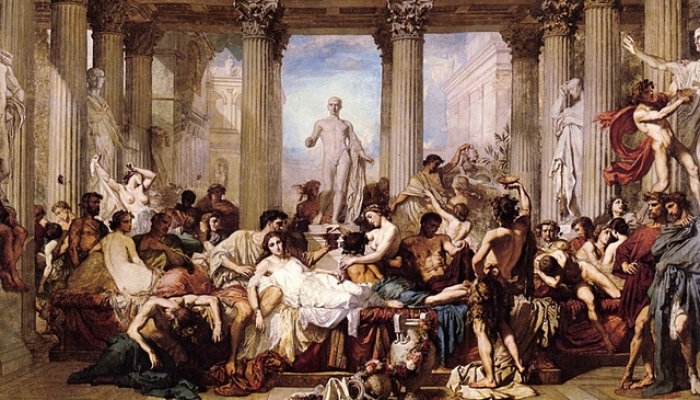
Posted by JD Hull at 08:24 AM | Comments (0)
October 14, 2014
The Holy Surprise of The 12 Rules of Client Service.
Our world-famous 12 Rules of Client Service. Revel in their wisdom. Ignore them at your peril. Teach them to your coworkers. Argue about them. Improve them.
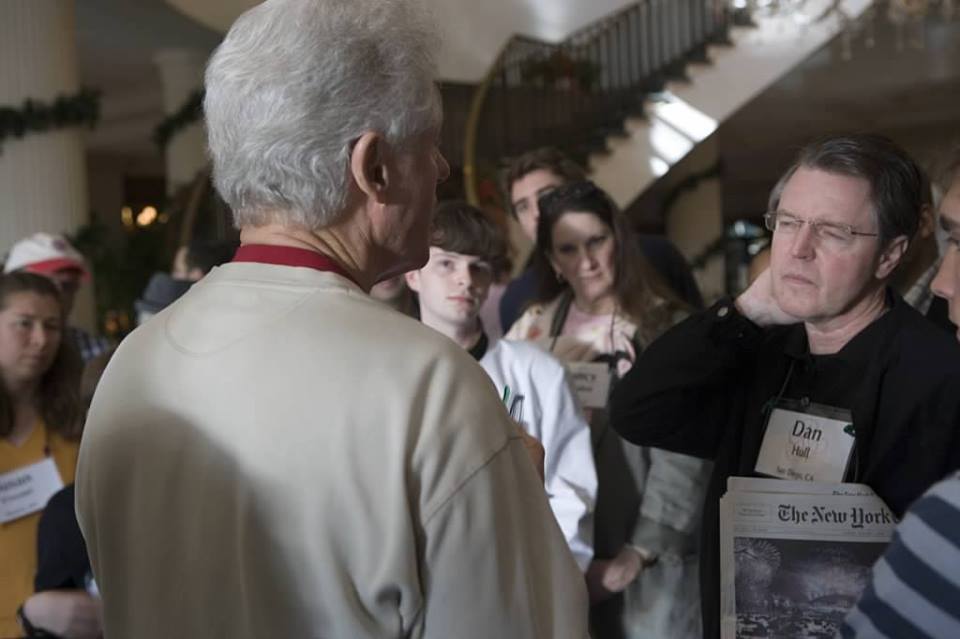
Posted by Holden Oliver (Kitzbühel Desk) at 11:59 PM | Comments (0)
October 13, 2014
Stormy Monday: Good morning, Buckeyes!
Posted by JD Hull at 04:39 PM | Comments (0)
October 11, 2014
Congratulations, Mr. and Mrs. Richard Chiem
Melrose Market, Seattle, 5:00 pm, October 11, 2014. Officiant: John Daniel Hull
.jpg)
Posted by JD Hull at 04:40 PM | Comments (0)
October 10, 2014
Si'ahl or Chief Seattle (1780-1866)
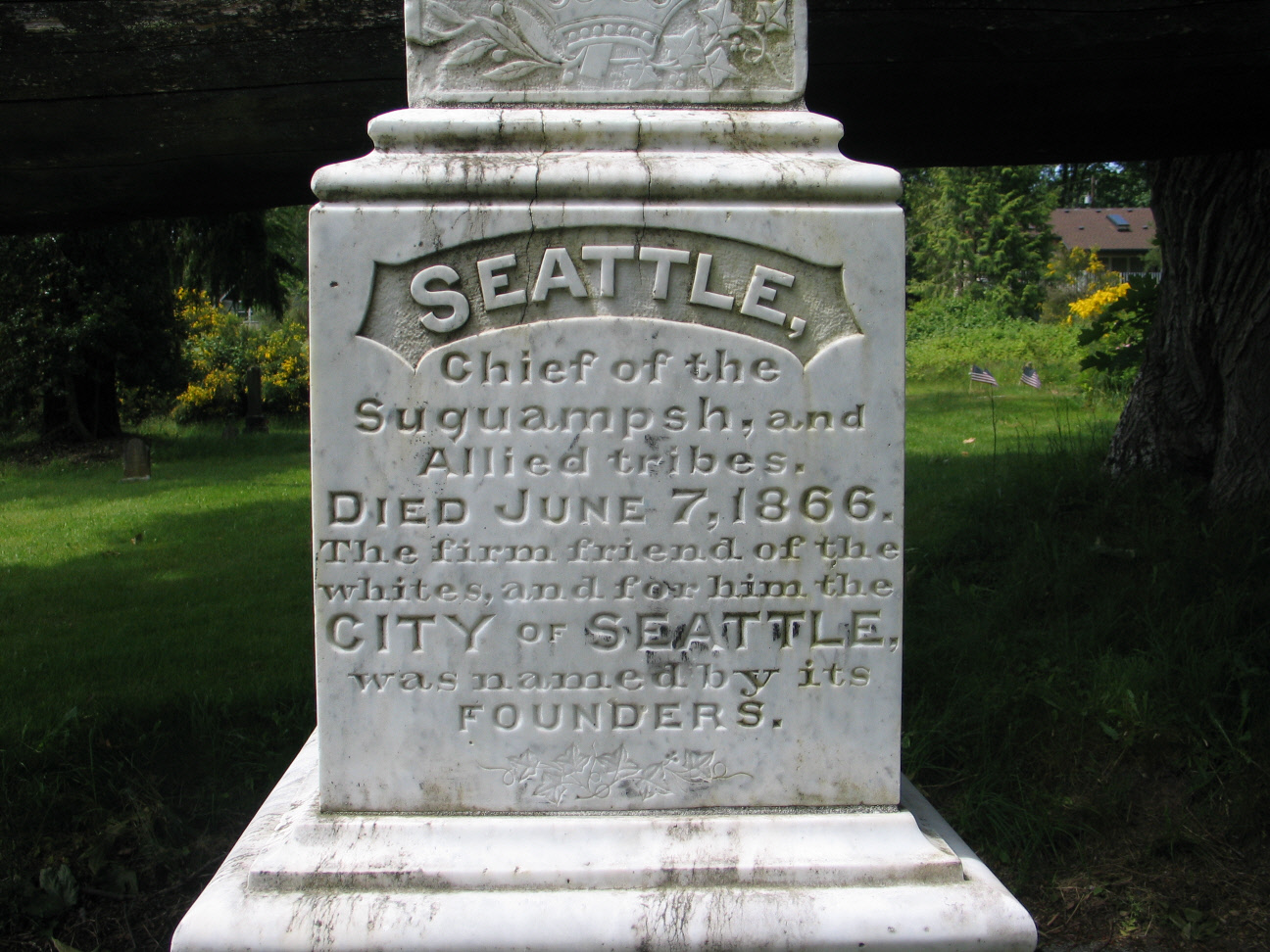
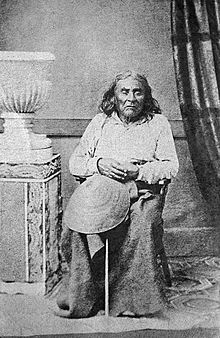
Only known photograph, 1864.
Posted by JD Hull at 11:30 PM | Comments (0)
A Nod to Old Blighty
Ray Davies cries "Victoria", Glastonbury 2010
Posted by JD Hull at 08:14 PM | Comments (0)
October 08, 2014
Irving: On Writing Well.
Half my life is an act of revision.
--John Irving (1942-)
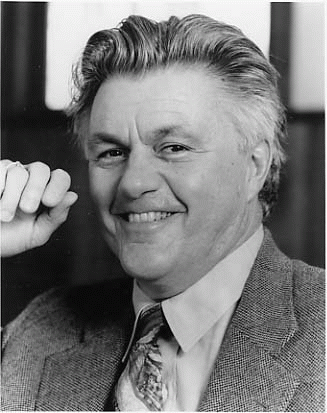
Posted by JD Hull at 01:14 PM | Comments (0)
October 07, 2014
Ben Bradlee Story #2: "What did you do in WWII, Ben?"
In our series, and also from the June 6, 2012 edition of Vanity Fair:
in 1984, the Washington Post published data it had obtained about a satellite payload, and some officials in the Reagan administration were not pleased. Managing editor Bradlee's patriotism was publicly questioned. There were even suggestions that at one time he had worked for the Kremlin. Bradlee, like his friend John Kennedy, was a World War II veteran who had served in the Navy. One right wing writer made the mistake of asking Bradlee "What did you do during WWII?". Bradlee's response began:
Dear Asshole:
I suspect I did more for my country in the war than you did. I spent four years in destroyers in the Pacific Ocean. My theatre ribbon has 10 battle stars on it.
That's just for starters.
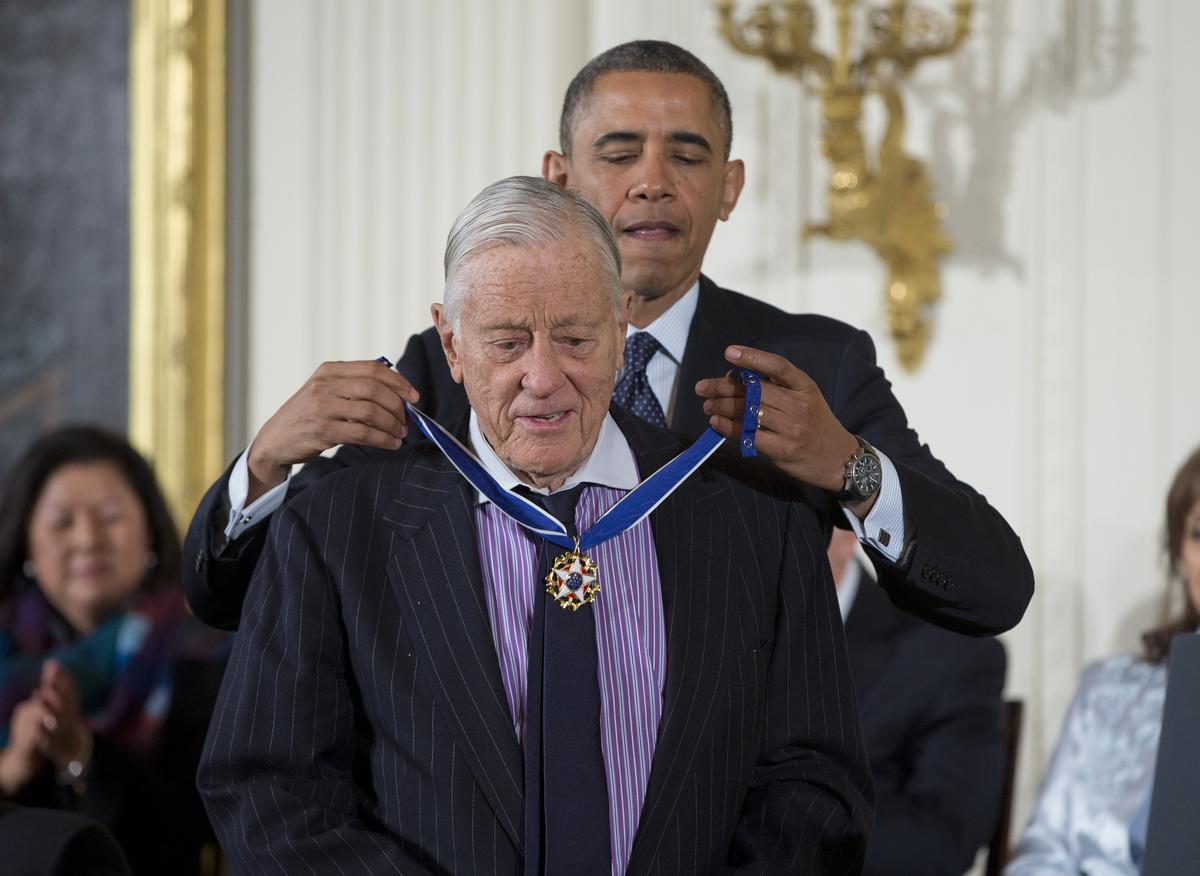
Bradlee receives the Presidential Medal of Freedom on November 20, 2013.
Posted by JD Hull at 11:28 PM | Comments (0)
October 05, 2014
Pantheon: Sarah Silverman.
"I don't set out to offend or shock, but I also don't do anything to avoid it."
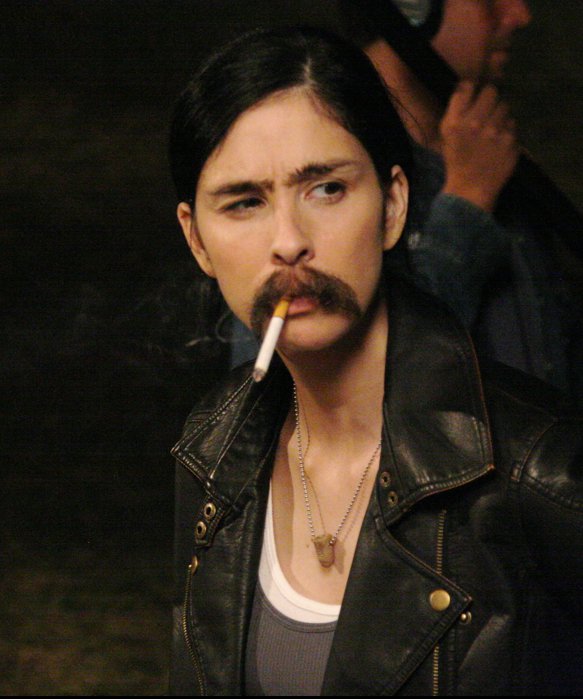
Posted by JD Hull at 06:35 PM | Comments (0)
Junior Walker: "Shoot 'em 'for he run now."
For all you prisoners of rock 'n' roll.
Posted by JD Hull at 03:51 PM | Comments (0)
October 03, 2014
Want to find out what pros think of your unpublished novel?
Double Bridge Publishing Company, Inc.. Double Bridge is a new online publishing service based in Washington, D.C. launched last month by Florida businessman Richard O'Brien. Double Bridge uses a crowdsourcing model to identify, evaluate, edit, market and publish fiction and nonfiction works of published, unpublished and new authors. It was established to get the best writing to an eager reading public without the usual bottlenecks caused by entrenched literary agent-publishing house regimes that affirmatively limit the number of titles published each year.
Unlike most established brick and mortar publishers, Double Bridge relies on crowdsourcing for much of its publishing functions, and provides valuable review services, close to cost, to writers and the public. A manuscript is reviewed for a small fee by several qualified reviewers who help decide the next steps for the work. Double Bridge has over 100 reviewers to critique and edit manuscripts quickly, usually within 24 hours, to get the process moving in the right direction. If you indeed know writers who are seeking publication of their work, please let me know who they are or have them contact me by our blog, by Messenger or by emails. Just find me. See also www.doublebridgepublishing.com.
.jpg)
Posted by JD Hull at 06:00 AM | Comments (0)
Prisoner of Rock 'n' Roll: The Eagle Flies on Friday.
Posted by Holden Oliver (Kitzbühel Desk) at 01:49 AM | Comments (0)
October 02, 2014
Authentic and American: Ben Bradlee Story #1
Earlier this week we weighed in briefly on the life of former Washington Post managing editor Bill Bradlee, now 93 and ailing. Bradlee served at the Post during a long and often-turbulent period in American history (1968-1991). There are lots of great stories about Bradlee--who was outspoken, forceful, combative and funny. Many highlight verbal or written comebacks Bradlee made to those who made unfriendly or hostile remarks about the Post or him. During a spat with the publisher of another newspaper, Bradlee once wrote:
To the Publisher:
Editors do run the risk of appearing arrogant if they choose to disagree with anyone who calls them arrogant.
You sound like one of those publishers who aims to please his pals in the community and give the what they want.
No one will call you arrogant that way. No one will call you a newspaperman, either.
Source: Vanity Fair, June 6, 2012
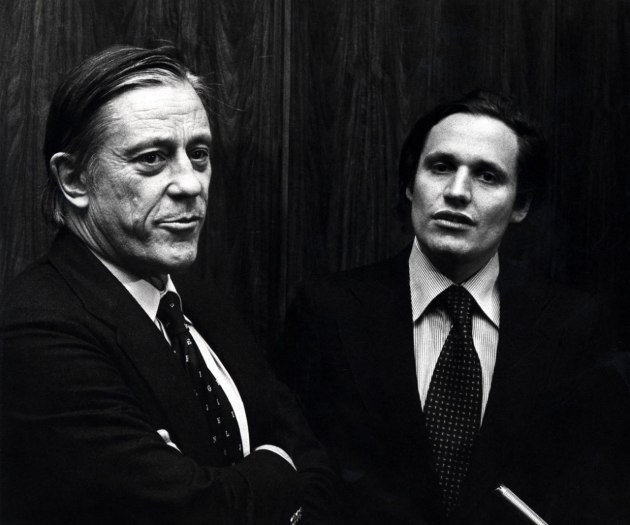
Bradlee and Washington Post reporter Bob Woodward circa 1980.
Posted by JD Hull at 04:31 PM | Comments (0)
October 01, 2014
Desperately Seeking: Who is the Blonde Woman who first appears at 2:30 in the clip?
Guess I'm hooked. Who is she? She would have been born around 1956 at latest, I think.
Posted by JD Hull at 11:55 PM | Comments (0)
.jpg)